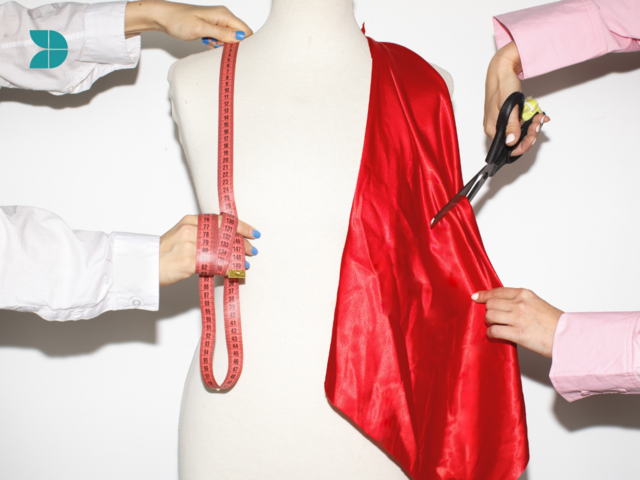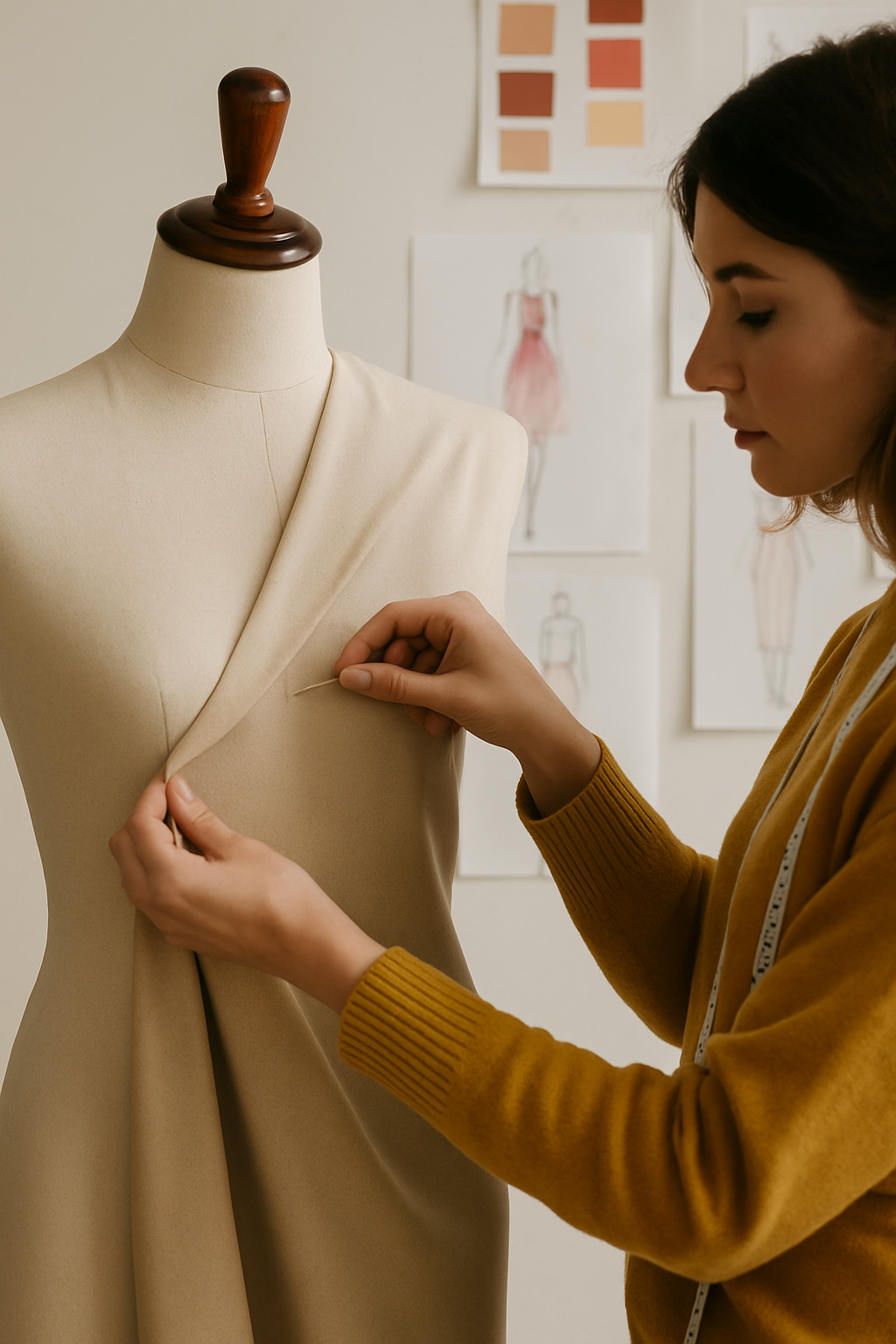The British Academy of Fashion Design is so proud of our faculty, that we love nothing more than to sit down and pick the brilliant brain of one of our tutors. Meet Sinead Garcia. Sinead has over 10 years under her designer belt, as both a professional pattern cutter and fashion designer. Before turning freelance, Sinead worked with the highly esteemed designer John Rocha as well as the renowned manufacturing company Styletex but before that, as with all professionals, she too had to start somewhere. Sinead was kind enough to let us peek inside her great design mind and tell us about her path to fashion, to the academy and some lessons she has learned along the way.

Q. Firstly, can you tell me a little about yourself – your journey into fashion design and how you found yourself teaching at the academy.
I initially chose sculpture at art uni. As much as I enjoyed it, I found the practice very solitary. Being a fine artist involves working on your own as opposed to working as part of a team. I decided to take a year out to work and review what direction of study to take the following year. I have always loved film, and the magic of cinema, tv series and music videos were so inspirational.
I remember I would become a little obsessed by a particular style – and because I could never find these kinds of items in the clothes shops, I started sketching and re-designing them in a notebook. These drawings were the beginnings of a fashion sketchbook. I took time that year to build a fashion portfolio and applied to second year fashion. The Fashion degree course suited me so much better, and I loved the work, and our class made it so much fun!
It was through Siobhan from the academy that I started tutoring at the British Academy of Fashion Design. I knew her through a studio in Dublin and she reached out to me and asked if I would be interested in becoming a tutor.
Q. In your experience, to become a fashion designer do you need to have a creative mind, an artist’s mind?
If you enjoy the process of creating designs and working with fabric, then you can work towards becoming a fashion designer. A small or simple idea can be the starting point of a bigger project or body of work.
Q. There are skills and techniques that can be taught but can creative thinking be taught?
On the course we introduce students to tried and tested ways that designers use to generate designs – like sourcing inspiration, sketching, collage, and draping. Practicing these techniques helps students to tap into their creativity and express their ideas.
Q. What would you say is the greatest misconception about fashion design and the industry?
I would say how much hard work is involved! Working in the fashion industry is often very hands-on and demanding. I think creative passion is the thing that will drive your career – there is something very magical when someone uses your design, or your pattern and you can see your contribution materialize in a show or something – this is the reward.
Q. When approaching a new collection, what comes first – e.g. theme, colour, season, comfort, gender, practicality etc. What’s your process?
I start by collecting inspirational images from multiple sources. I like to print out lots of images, spread them out on a table and form clusters of the ones that look right together - if that makes sense. Then, introduce fabric swatches and maybe vintage garments for silhouette. While sketching or draping I think it’s important to have the inspiration images visible on a foam board.
Q. When you were starting out, how did you break into the industry and get paid work?
Volunteering at fashion shows is great because it gives you the opportunity to meet the brand’s team in person. I secured a great job by interning for design studios in Paris and Dublin first – It is also imperative to have a current portfolio to show employers.
Q. Is there anything you would advise potential students to think about, read, observe, or indeed learn – before embarking on their fashion design studies?
I would say the best way to prepare for fashion university is to speak to current students and alumni of fashion colleges, attend open days, read / watch interviews of your favorite designers, maybe do a beginner sewing, draping or pattern cutting course, visit fashion and textile museums and exhibitions and watch fashion documentaries.
Q. Is there anything you have observed in students that frustrates you – perhaps they arrive with bad habits or the wrong expectations – or anything else?
Learning a new skill, no matter what it is, can be very challenging at times. Progressing at a slower pace to your fellow student or making mistakes are aspects that understandably frustrate students. However, it’s helpful to view them as a necessary, valuable even, part of the process.
Q. Sustainability and circular approaches to textiles and manufacturing are very important paths to follow but have you seen significant changes not just in practice, but in attitudes in students and designers – are they more than buzz words?
There's a lot of noise about sustainable practices on social media platforms, marketing campaigns etc. but greenwashing is also prevalent. Sometimes it's hard to know if a brand is really invested in sustainability for the right reasons or if it is just marketing. There are some brands and companies implementing amazing initiatives like the Good On You app.
Good On You is a great platform because it analyses and rates fashion brands' standards of ethics and environmental conscientiousness. The greenwashers and those who are legitimately implementing real positive change are listed for consumers to see.
Q. What is the most interesting / rewarding part of teaching at the academy?
Meeting new students from different social, ethnic backgrounds is always exciting. No two intakes are the same and tutoring to such a diverse range of people teaches me about so many cultures and new ways of looking at the world. Helping them discover their creative ability, develop their skills, and make progress is so rewarding. Creating better content, in-class tasks and improving class delivery methods is very fulfilling. I love that the colleagues I've met through BAFD have become good friends.
Q. Finally – what are your fashion pet peeves and your fashion favourites – it can be designers, fabrics, accessories, colours, the way they are worn, anything at all…?
Fashion Peeves:
- The growing exclusivity or elitism of luxury fashion brands.
- Fast fashion being sold as vintage in second hand shops.
- The fact that the quality of high street clothing and fabrication has degraded so much in the past 20 years - it is difficult to find decent styles that lasts for a reasonable price.
Fashion Favourites:
- Heritage crafts like knit, crochet, embroidery and weave are just a joy to behold! I love the Aran jumper!
- Finding a beautiful vintage garment that fits is just the best.
If the words of our tutor Sinead Garcia have sparked something inside you, perhaps it’s time you took that first step on your own road to fashion design. Check out our selection of accredited fashion design courses as well as our variety of study modes. All you need is a passion for fashion, and we can find a course that is the perfect fit for you.

